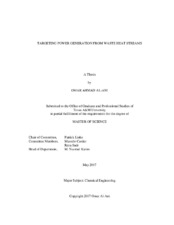Targeting Power Generation from Waste Heat Streams
| dc.contributor.advisor | Linke, Patrick | |
| dc.creator | Al-Ani, Omar Ahmad | |
| dc.date.accessioned | 2019-03-07T15:44:09Z | |
| dc.date.available | 2019-05-01T06:10:09Z | |
| dc.date.created | 2017-05 | |
| dc.date.issued | 2017-04-24 | |
| dc.date.submitted | May 2017 | |
| dc.identifier.uri | https://hdl.handle.net/1969.1/174889 | |
| dc.description.abstract | The paper proposes two procedures to target thermodynamic power generation limits from a set of heat source streams. The first procedure takes the form of an algebraic targeting approach commonly applied in process heat integration. This procedure is based on fundamental thermodynamics laws and the Carnot cycle. The procedure allows the designer to quickly determine the maximum amount of power that can theoretically be generated from the available heat in thermodynamic cycles. The second procedure uses the Rankine cycle to determine the amount of power that can be generated using a real power generating cycle. The paper describes both procedures and their applicability in the context of common data availability for heat source streams in the form of Composite Curves or Total Site Profiles (hot composites) commonly developed in heat integration. The application of both procedures is illustrated with examples. | en |
| dc.format.mimetype | application/pdf | |
| dc.language.iso | en | |
| dc.subject | waste heat | en |
| dc.subject | power generation | en |
| dc.subject | Carnot cycle | en |
| dc.title | Targeting Power Generation from Waste Heat Streams | en |
| dc.type | Thesis | en |
| thesis.degree.department | Chemical Engineering | en |
| thesis.degree.discipline | Chemical Engineering | en |
| thesis.degree.grantor | Texas A & M University | en |
| thesis.degree.name | Master of Science | en |
| thesis.degree.level | Masters | en |
| dc.contributor.committeeMember | Castier, Marcelo | |
| dc.contributor.committeeMember | Sadr, Reza | |
| dc.type.material | text | en |
| dc.date.updated | 2019-03-07T15:44:10Z | |
| local.embargo.terms | 2019-05-01 | |
| local.etdauthor.orcid | 0000-0003-2876-382X |
Files in this item
This item appears in the following Collection(s)
-
Electronic Theses, Dissertations, and Records of Study (2002– )
Texas A&M University Theses, Dissertations, and Records of Study (2002– )


